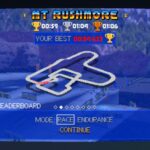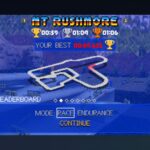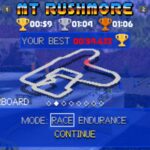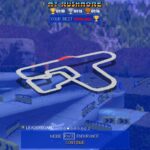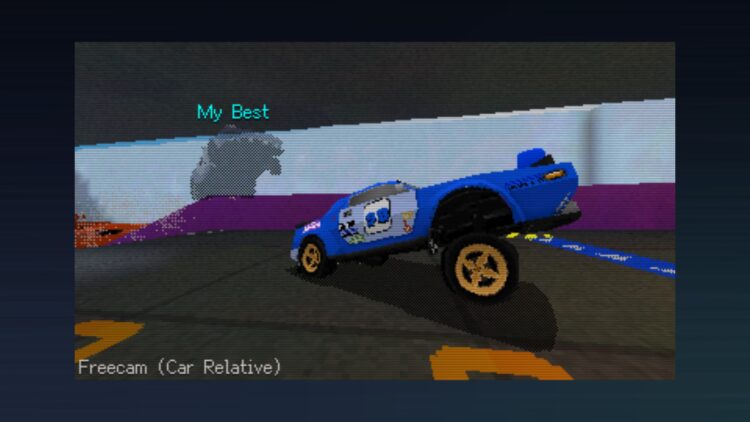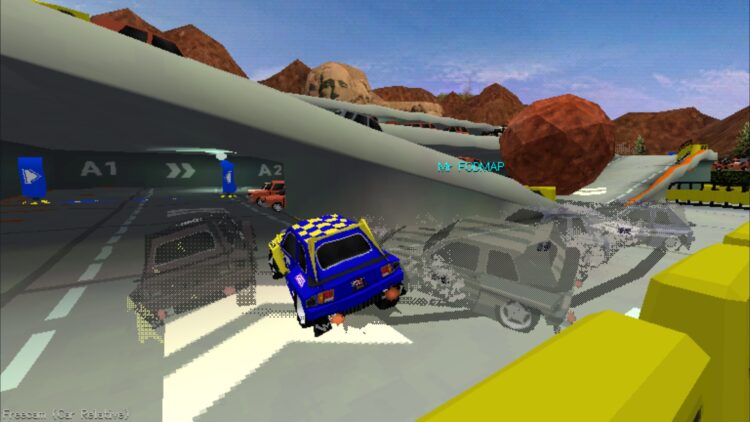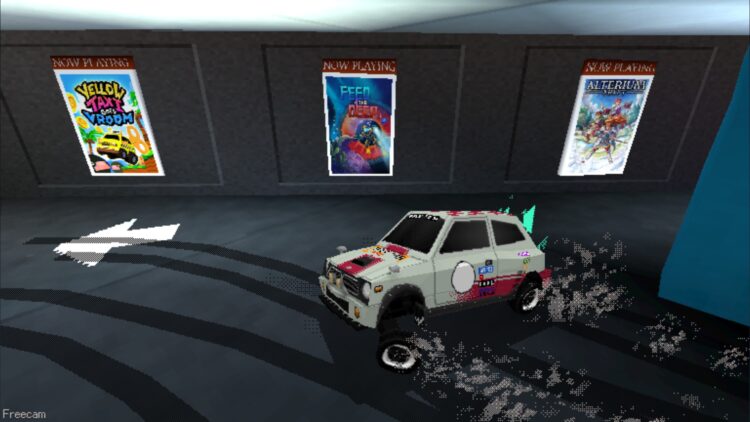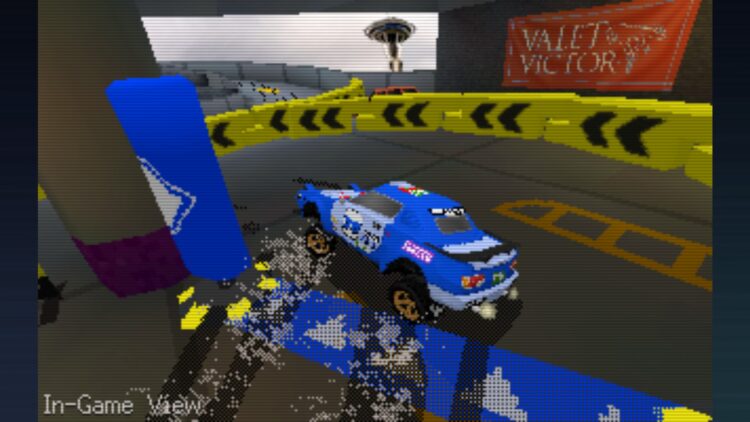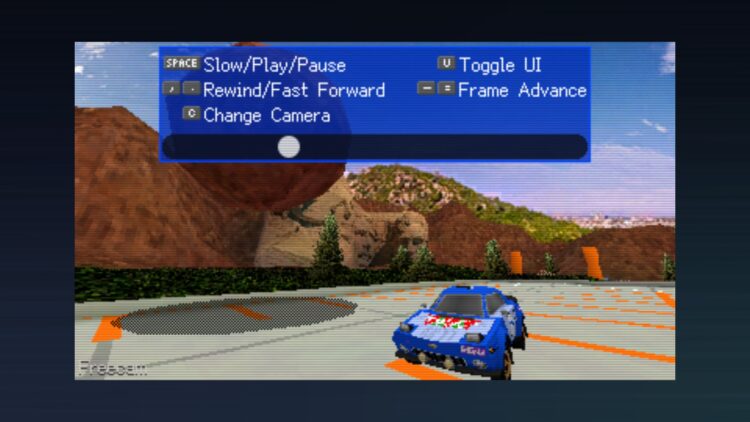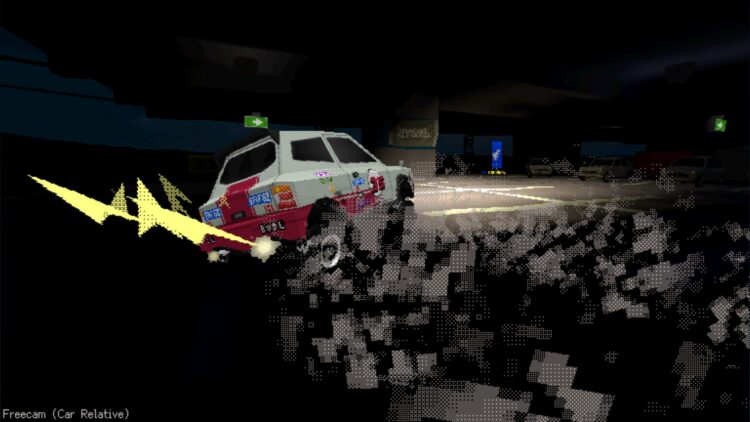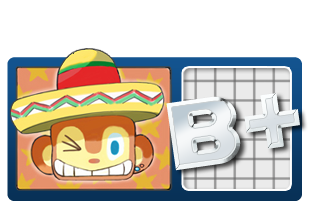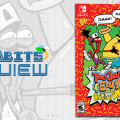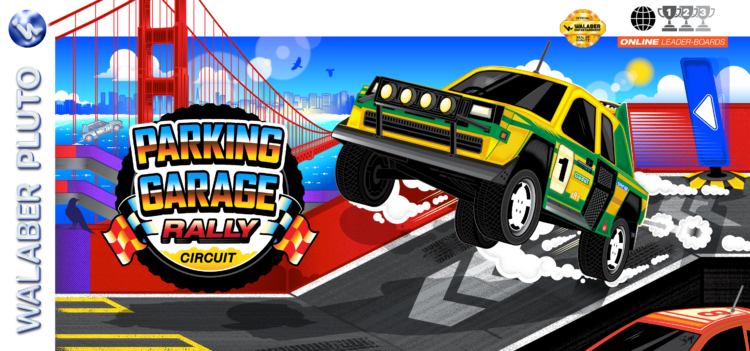 If you yearn to revisit the glorious need for speed that Sega provided you with stellar 90’s arcade racers like Daytona USA, Sega Rally Championship, or Manx TT Superbike, you’re not the only one. A few developers have begun taking a crack at recapturing that spirit with some brand new games. Today, we’re putting a spotlight on one of the newest games of that bunch: Parking Garage Rally Circuit. Developed by Walaber, whom we’ve had the pleasure of speaking to about this game before, PGRC aims to be the Sega Saturn racing hit that never was. A frantic time trial racer that aims to emulate the look of 90’s 3D console racers to an extreme degree, a lot of passion for that unforgettable time in gaming history is as clear as the blue, blue skies the game graces you with, but does that passion equal a game that’s as worthy of your time as most any racer Sega had developed during that decade? Find a cozy parking spot to sit back, relax, and read through our review of Parking Garage Rally Circuit after the break.
If you yearn to revisit the glorious need for speed that Sega provided you with stellar 90’s arcade racers like Daytona USA, Sega Rally Championship, or Manx TT Superbike, you’re not the only one. A few developers have begun taking a crack at recapturing that spirit with some brand new games. Today, we’re putting a spotlight on one of the newest games of that bunch: Parking Garage Rally Circuit. Developed by Walaber, whom we’ve had the pleasure of speaking to about this game before, PGRC aims to be the Sega Saturn racing hit that never was. A frantic time trial racer that aims to emulate the look of 90’s 3D console racers to an extreme degree, a lot of passion for that unforgettable time in gaming history is as clear as the blue, blue skies the game graces you with, but does that passion equal a game that’s as worthy of your time as most any racer Sega had developed during that decade? Find a cozy parking spot to sit back, relax, and read through our review of Parking Garage Rally Circuit after the break.
(A Steam copy of the game was provided by Walaber for the purpose of this review. They have not influenced the review in any other way and have not read it before it went online.)
Creamy 3D Graphics!
As I booted up PGRC for the first time, I was immediately met with four choices of graphics presets. From this screen alone, the care that was taken in emulating the look of 90’s games is undeniable. The first preset is, as you would expect, meant to simply copy the look of a Saturn 3D game to a tee, but the other three are options that you wouldn’t expect. First is a modern emulator option, meant to try and copy the imperfections of a 3D Saturn game as viewed through a software emulator on your computer such as Mednafen or SSF. Next is a modern handheld option, meant to copy the look of emulators on handheld devices with LCD screens such as, presumably, the Ambernic or Powkiddy handheld emulator systems that are all the rage with retro enthusiasts today. Finally, there’s a PC Port option, made to look like an official high-res PC conversion of the fantasy Saturn version of PGRC, much like Sega’s own retro PC ports of their own Saturn games like Daytona USA or Sega Rally Championship. No matter which option you choose, the core gameplay remains the same, and you are free to select another preset in the options menu later.
Each preset has several factors to it, such as all options besides the PC port option locking the game at 30 fps, lowering the overall native resolution, or keeping the draw distance close. When the draw distance is lowered, environmental objects instantly pop into view, just like the original Saturn version of Daytona USA. When the native resolution of the game is low, textures and 3D models jitter all over as they move around the screen, just like any 3D game on Saturn or PlayStation. No transparency effects are evident anywhere in the environment, such as light rays from headlights or lamp posts or dust kicked up from the tires. Instead, these effects show a clear “dithering” look, which is how Saturn and Genesis/Mega-Drive often displayed objects meant to appear transparent by taking advantage of a CRT television or monitor’s natural glow to blend those pixels together because neither the Saturn nor Genesis were capable of producing natural transparency effects, unlike the PlayStation, Nintendo 64, or even the Super Nintendo. All of these little details come together to produce a look that is incredibly faithful to how Saturn games looked. You can also toggle individual values to your exact liking in the options menu if you’re not satisfied with how any of the presets are already.
Gentlemen! Start Your Engines!
With your mind set on a graphics preset, starting the game and jumping straight into single player mode sees you picking a car to race with. At first, you have just one and beating all the race courses with that car unlocks a new, faster car, then beating each course with that car unlocks the fastest car in the game. You still get some variety with either ride, as you get to select from multiple decals and colors to mix and match and choose a number between 1 and 99 to display on the side of the car. After that, and a brief tutorial for the controls, you can begin racing on the first course, the shortest in the game, and unlock each course one by one by placing with in the top 3 fastest overall course times. Beat the #1 fastest time and the game will automatically download the fastest times of all other players online who have beaten the preset #1 time and you can begin racing against the ghosts of a handful of people ahead of you.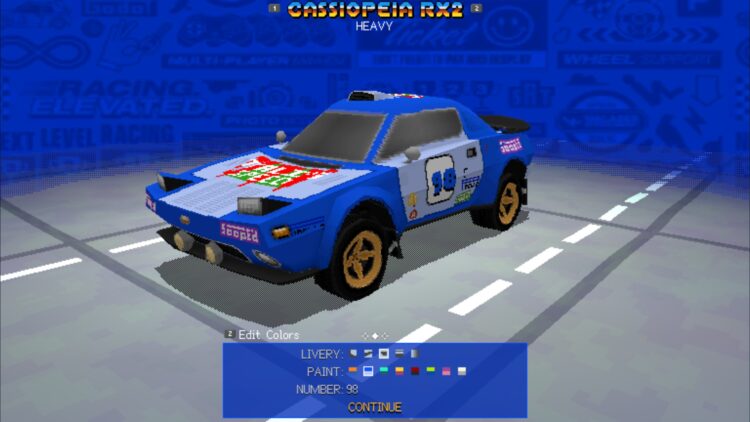
Unlike most racing games, PGRC is strictly a time trial racer. You only race against ghosts of other players which you cannot collide with or hinder in any way, but considering each race course is inside a parking garage, they are far too narrow for multiple racers to drive through at a time anyway. If you’re not used to time trial modes in racing games, then a lot of the intensity of these races may be lost on you. Since you’re still racing for the fastest time possible, there is still some sense of competition, and it is thrilling to figure out the best way to turn each corner to shave some precious extra seconds off your previous best time and the time of other racers around the world.
As you race, there will be checkpoints in your path that you have to cross in order to be allowed to proceed, though driving through the blue bumpers on either side of them also counts. If you miss a check point, the game tells you to reset to the last checkpoint you hit with whichever button is assigned to do so in the options menu, and you may as well do that because hitting the next checkpoint anyway will just automatically send you back and waste your time. You can also hit a button to instantly reset the entire race if you feel you’ve already made too big of a blunder, which may be annoying if, again, you are not accustomed to time trial races or find it annoying to constantly restart the whole race.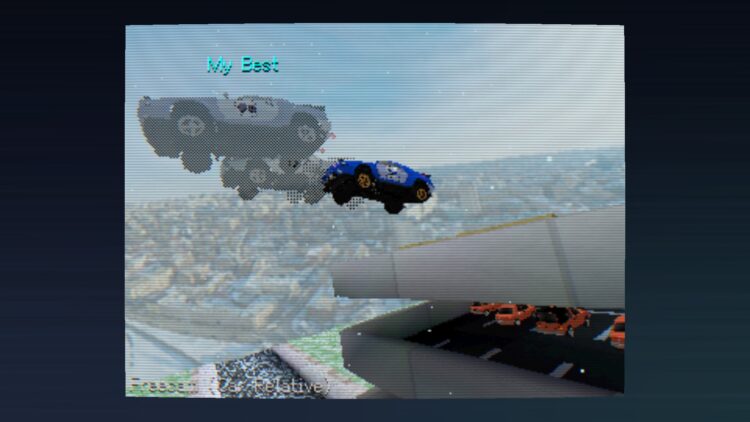
Try to go easy on the car!
Racers live or die by their control and physics, and PGRC is mostly solid in this aspect. The cars actually don’t go as fast as you’d expect to see in old school racers, mostly due to the comparatively cramped raceways, but there is a nice sense of speed and rhythm as you dash and drift around courses. Drifting is handled in a more modern, simplified way, with you holding down the drift button as you turn, just like in the Sonic & Sega All-Stars Racing series. Also, like those games, drifting builds up a turbo boost after releasing the drift button, while holding it down increases the power and duration of the boost. Releasing the drift button too early eliminates the boost as well as any boost that is still in effect during the drift. An audible clicking sound can also be heard if your boosts get cancelled out so you know when you’re about to revert back to basic top speed. Create enough drifts in a short time and you’ll go way over your car’s top speed for a longer period. Racing at sonic speeds while trying to squeeze in as many drifts as possible is exhilarating, but makes it much easier to crash or overshoot a jump if you’re not careful (Protip: drifting over an incline that suddenly levels out actually prevents your car from going airborne, which is often critical), and it also highlights a crippling flaw in the feel of the game.
The car physics feel about as loose as the control of the car feels solid. Your car is so lightweight, that it feels more like you’re driving a big hunk of Styrofoam around instead of a ton of steel. Cars can easily fly out of control as soon as the tires leave the tarmac if you’re not careful and they can tumble around in ways that seem to make no sense. Sometimes, even lightly tapping a wall at high speeds can send you soaring out of control. In many cases, your car might fly well outside the boundaries of the track into spots that you are obviously not meant to reach by normal means. The game will only automatically reset you if you fly far outside the boundaries of the map or into a body of water, so, many times, you’ll be forced to manually reset yourself and waste precious time. While it is true the physics can sometimes be exploited to cut through certain parts of the track from one checkpoint to the next, the way the physics are doesn’t make this feel deliberate.
Run Through The Speed Highway.
What does not feel weak in the slightest is the racetrack selection. Excluding the tutorial level, you have eight courses to race through, each one seemingly longer than the last and taking place in a different American city. There’s a lot more variety in them than you’d expect from parking garages too. From the tumbling boulders deforming the road and blocking your way on Mt. Rushmore, to the long, winding turns filled with jumps and gates at Chicago Marina, to the snowy roads and rushing snowplows of Minnesota Mega Mall, a lot of surprises and challenges get thrown your way. Some hazards only activate on later laps, such as the aforementioned falling boulders in Mt. Rushmore or the power outage brought on by lightning in the nighttime course of New Orleans, which automatically causes the headlights of your car to switch on. Driving over dirt or snow also slows down your car a little, while creating a satisfying rumble with compatible controllers. There’s always plenty to see and plenty to keep you on your toes.
That being said, it is sometimes hard to see what direction you’re supposed to go. All parked cars on the track are arranged in such a way as to provide a cohesive track layout, and sometimes signs with arrows are placed to show you where you’re meant to drive. However, even with these layouts, some areas are so cluttered that it’s not always immediately obvious where you should be going. A couple of runs around the track will help you memorize the course, but it may take a few tries. Sega facilitated this issue with their own classic racers by placing cleverly designed landmarks on the courses to help remind you what turns or hazards are coming up, such as the Ferris wheel in Virtua Racing’s Easy course or the Jeffery McWild statue on Daytona USA’s Sea-Side Street Galaxy course. A couple of things like these might’ve helped in PGRC’s case as well, such as statues, posters, unique parked vehicles like a bulldozer or an 18-wheeler, anything like that, but few courses have anything like these or at least don’t have landmarks that stand out enough.
Hey. Wanna listen to some tunes?
What PGRC does have is a stellar soundtrack by the ska band The Holophonics, who have really stretched their musical muscle hard on this game’s soundtrack. Most songs are about what you’d expect from ska bands you may have heard before, but this one has a lot of pleasant surprises up their sleeves. First, every song is fast, loud, and exciting, as any good racing soundtrack oughta be, but the nighttime based New Orleans track has a classy, city pop sound to it that doubles down on saxophones. Minnesota Mega Mall’s song has funky basslines and more energetic saxophones, making the track feel a lot faster despite the snow slowing you down, helped very much by the track’s turns and hazards. Both songs sound sort of like a thrilling high speed police chase in their own way. San Francisco’s song actually has lyrics to it, which sound incredibly uplifting and exciting in all the ways that legendary Sega singers like Takenobu Mitsuyoshi, Dennis St. James, and Johnny Geoeli have captured in classic Sega arcade racer soundtracks. Even though this is ska punk and not the corny hard rock those three singers excelled in, the core feeling was still captured beautifully.
The song from the final track in the game, Liberty Island, is The Holophonics’s masterpiece, by far. The instant the race starts, you’re immediately met with intense, fast guitar licks that create a sense of danger and urgency, as you rush through the quick, sharp turns the course immediately starts you off with. As the song goes on and the trumpets come in, the song starts to feel less serious and take on a lighter tone, and then you get surprised by lyrics. Just like the first lyrical song, this song’s words are a triumphant declaration of intent to race like a champion. Whether it was deliberate or a happy accident, each of these parts of the song actually sync up with certain critical moments of the track (provided you’re running a decent race), like the trumpets coming in as you exit the garage and are met with the bright sun and the lyrics coming in as you take the curved dirt incline up to the Statue of Liberty. The lyrics seem to reach the second chorus as you run back around to the other entrance back into the parking garage and approach the starting line for the next lap. Even after starting the course over and over again due to multiple failed attempts at getting a good lap time, the music made the course feel just as jubilant as the first time I raced on it. I’ve even found myself singing the lyrics after stepping away from the game.
After each race, the game gives you the option of entering a replay mode to watch a video of your run through the course, which gives you a lot of control over its playback. You can pause, rewind, slow down, or speed up the video at your will, as well as move the camera, and it is fun to watch. As a matter of fact, all the screenshots shown in this review are screenshots I took myself using this feature. I made sure to take multiple screenshots with each of the visual mode presets too, allowing you to compare each for yourself.
The presentation is so amazing that I found myself wishing the game let you change your view, like most arcade racers allow you to do. Sadly, PGRC only gives you a basic, behind-the-car viewpoint. There’s no options for a view further away from the car, a drivers seat, or bumper view either. Neither of these are options in replay mode either. It would’ve been nice to have some more control over the view you have during the race, especially as some players might be more comfortable with certain views over others.
It’s also worth pointing out that PGRC does have an online multiplayer feature, allowing up to eight players to race in real time. Every player still appears as a ghost, so you cannot collide with any of them, but you can still see them on the track. Sadly, nobody currently plays this game online and, and because of that, I have never been able to test this feature for the review. Give it a try with friends if you can and tell us how it is in the comments below. Otherwise, you always have ghosts from the leaderboards to race against in single player mode and the local split-screen multiplayer mode, which I also wasn’t able to test.
The other fatal flaw of PGRC is that the game is completely shallow. Of course, a lot of arcade racers from the 90’s are more shallow than some of you may remember, so this isn’t entirely a bad thing. However, with only eight tracks, time trial races only, and a mostly dead online multiplayer community from day 1, you’re likely to get bored quick if you’re used to meatier racers and not too fussed about endlessly practicing to place yourself higher and higher on the leaderboards. Thankfully, the price of the game is fittingly low, even without a discount, so you’re still getting your money’s worth here.
Virdict:
As a retro racer, Parking Garage Rally Circuit is a fun and fresh take on racers with its setting and structure and a wonderful love letter to the Sega Saturn. It may not feel quite like the racers of the day and does still employ some modern gaming touches, but it’s a thrilling joy ride that any racing fan should check out. Its physics issues are the only major flaw that really holds it back from greatness, as having such featherweight cars can really mess with your careful driving and ruin the race in ways you’d never see coming, but it happens just infrequently enough to not ruin the whole experience. The presentation is top notch and very faithful to the time period it seeks to pay tribute to and the music supports the action in ways that few modern throwback games have been able to capture. Go take this game for a spin and show everyone your best runs.
Parking Garage Rally Circuit is available for Windows and Linux on Steam and, while not officially marked as Steam Deck compatible, the developer says in a Steam update that it is, so try it for yourself if you have one (Because at the time of this writing, I don’t). The game is available on it’s own for $9.99 USD, plus the soundtrack is available separately at $9.99 or bundled with the game for $16.98, and I strongly suggest buying the game and soundtrack bundle because, as stated earlier, the soundtrack is amazing. You can check out the rest of The Holophonics’s music here. EDIT: The Holophonics now sell the game soundtrack as a vinyl record on their Bandcamp page.
Positives:
- Visuals so Saturn-like you’d swear it was a real Saturn game (or an old school PC port of one)
- Kinetic, snappy, and satisfying driving and drifting controls
- Creative and thrilling racetrack designs
- Did I mention The Holophonics’s soundtrack is amazing?
Negatives:
- Nonsensical physics with cars often feeling too weightless
- Racetrack layout unclear without time to accustom yourself with them
- Limited view options
- Nonexistent online community
- Not for players who find time trial modes in racing games boring or unfulfilling
Ad:

